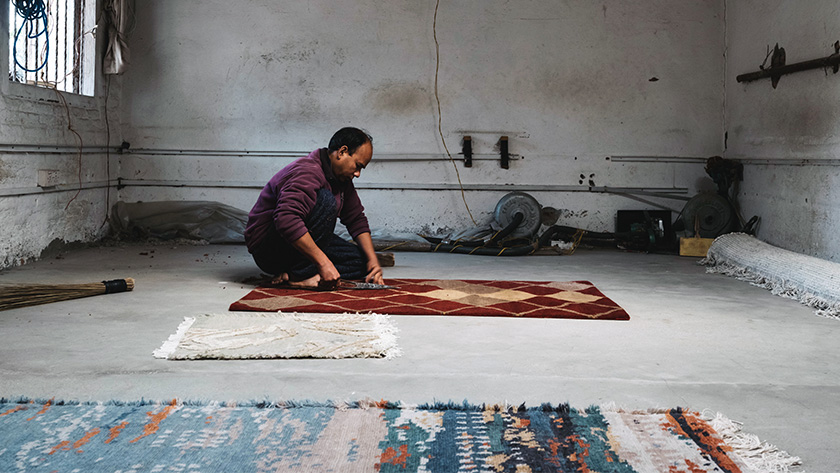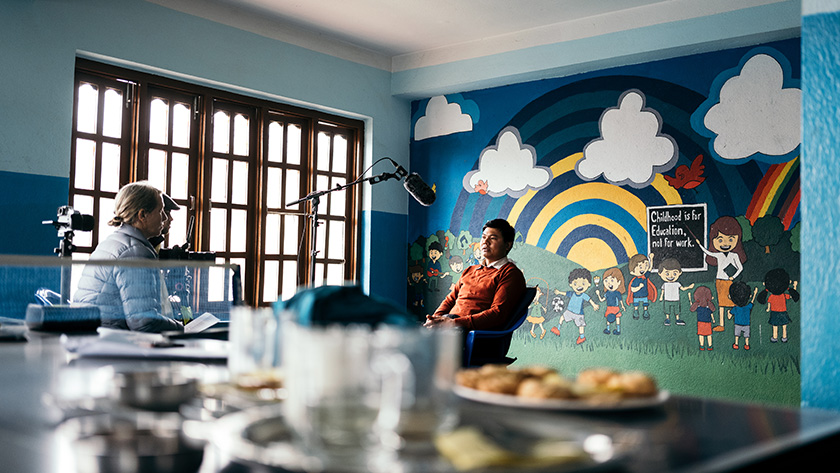To be a hero is to take a risk. Hem Moktan does this every day, facing his brutal past as an enslaved child. He is featured in the documentary film Hem Moktan: He Made It, that debuted on June 10, 2020, to mark this year’s World Day Against Child Labor. I first met Hem 20 years ago. During production this past February, I spent time with him in Kathmandu and learned more details of his life. His story sheds light on the 152 million child laborers around the globe who have yet to be freed. Amidst COVID-19 that number could increase, as people become desperate for work on any terms.
Hem Moktan taught me that you do not need to die to lose your life. From age 10 to 13, Hem was forced to weave carpets to work off the advance paid to his father. He endured beatings, illness and hunger. He worked in conditions defined by the International Labor Organization as the “worst forms” of child labor. Hem calls this a time when he was some other being, not a human being, “when I was lost.” Now with a master’s degree and a Ph.D. in process, Hem serves the organization that facilitated his freedom and I proudly call him my colleague. In his role, he has helped hundreds of children to regain their freedom, and their lives.
Hem’s story is a reminder that the shirt you wear, the carpet under your feet, and so many other things you touch every day, may have passed through the hands of an exploited child. Now as we raise awareness through World Day Against Child Labor and while many businesses are struggling to survive the COVID-19 crisis, this is a chance to support the ones that act to stop child labor. Know who made the products you buy and put a stop to child labor, insist on the GoodWeave® label.
Hem’s ordeal started when a man, a labor broker, came to his squatter settlement. His parents were farm laborers, and could not earn enough to provide for their six children. So, when this man offered Hem’s father food, clothing and a salary for work in the city, he considered it a great opportunity for his son.
Hem and some other children were brought to a Kathmandu carpet factory, where his parents’ hopes quickly dissolved.
Each day he wove carpets from 4:00 or 5:00 a.m. until 1:00 p.m., sometimes all night. The yarn dug wounds into his small hands. “It was the most painful in the winter,” Hem remembers. “The ache didn’t go away.” He had only two daily breaks to eat a plate of white rice with watered down lentils and mushura (a cheap soybean vegetable). He lived and worked in the dirty and overcrowded factory, suffering pneumonia, typhoid, chronic diarrhea and skin disease. Hem and some others slept on the floor of a hot, windowless storeroom that stunk from its previous use as a toilet.

The worst, he says, was torture. “My master [the main factory supervisor] was actually good to me…but the other weavers were the problem.” They tormented Hem. He was the youngest, and a slower weaver. They did not call him by name, just “little boy.” They beat him with long iron rods and balling equipment. “When I complained to my master,” Hem recounted, “the weavers became even more aggressive. So, I stopped complaining.” In three years, Hem earned only 3,000 rupees—the equivalent of 45 US dollars.
A GoodWeave inspector, Drona Adhikari (who himself was a child laborer), rescued Hem from the factory and with his parents’ permission brought him to live in our transit home. He received counseling, attended school, and his childhood was slowly restored. Just leaving the factory was an act of courage; Hem was threatened with rumors that GoodWeave takes children to an even worse place. I am so glad that Hem believed us. He entered the transit home on New Year’s Eve.
“From that day I got new life,” he told us. The next day he joined the other children for the annual common birthday celebration (many do not know when they were born). Then Hem started kindergarten at age 13. He quickly jumped grades and strived ahead to graduate high school on time.
Hem and I visited the factory where he worked, in a back ally where it would be easy to hide exploited workers. The owners showed up—Hem had told them we were coming and they wanted to show us that since their factory became part of GoodWeave’s inspection and monitoring program, working conditions had improved and children were never employed again.

As they talked of Hem with pride, I marveled to myself that he showed them no anger. Later that day, we went to the Higher Laboratory Secondary school, where GoodWeave sponsors several students. He stopped to greet one of them, later explaining, “I rescued Akash while I was an inspector.” Hem remains in touch with other former victims. Among them are bankers, government workers and business people. On the day we spoke, he had just received a call from one young man who is in training to be a police officer.
“Sharing my story is an opportunity to give thanks,” says Hem. In January he sent me New Year’s wishes in the most beautiful letter, thanking me and all of GoodWeave’s donors. “We are from different parts of the world but they are supporting us in the name of humanity,” he wrote.“Especially those children who have lost the happiness and hope of life.”

Hem fulfilled his dream to be an educated person, which he did not abandon during his servitude. “I had to get an education—that was my main motto,” he told us. He even pieced together a makeshift uniform one day and joined a group of boys in their walk to a nearby private school, pretending to cradle an armful of books in front of himself. The factory owner’s son attended that school.
Hem encourages all the rescued children to have ambition. He motivates them by sharing his story. His own goals extend to his siblings, too. He has helped support his family and paid for several to attend school. His little sister is just getting her bachelor’s degree. He says everyone in the village now looks up to them.
Hem says that sometimes companies don’t have humanity, and just focus on the money, keeping child labor hidden from the people who would do something about it. He was found because a company enrolled in GoodWeave’s certification program. Such partnerships make it possible to locate and rehabilitate victims, and more importantly, transform business practices and prevent further exploitation.
In honor of World Day Against Child Labor, join us to free the 152 million children laboring in the world today. Here’s what you can do.
He sat in front of a rainbow mural at Hamro Ghar as he told us his story. Above his head were the words, “Childhood is for education, not for work.” While he had to stop several times to recompose himself as he recalled painful memories, he did so with honesty and purpose. Thank you Hem.